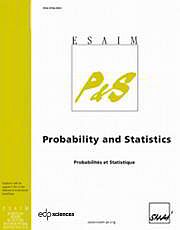No CrossRef data available.
Article contents
Random thresholds for linear model selection
Published online by Cambridge University Press: 23 January 2008
Abstract
A method is introduced to select the significant or non null mean terms among a collection of independent random variables. As an application we consider the problem of recovering thesignificant coefficients in non ordered model selection. The method is based on a convenient random centering ofthe partial sums of the ordered observations. Based onL-statistics methods we show consistency of the proposedestimator.An extension to unknown parametric distributions is considered. Simulatedexamples are included to show the accuracy of the estimator.An example of signal denoising with wavelet thresholding is also discussed.
Information
- Type
- Research Article
- Information
- Copyright
- © EDP Sciences, SMAI, 2008
References
Abramovich, F. and Benjamini, Y., Adaptive thresholding of wavelet coefficients.
CSDA
4 (1996) 351–361.
Antoniadis, A., Bigot, J. and Sapatinas, T., Wavelet estimators in nonparametric regression: a comparative simulation study.
J. Statist. Software
6 (2001) 1–83.
B. Arnold, N. Balakrishnan and H. Nagaraja, A first course in order statistics. Wiley series in probability (1993).
Barron, A., Birgé, L. and Massart, P., Risk bounds for model selection via penalization.
Probab. Theory Related Fields
113 (1999) 301–413.
CrossRef
Birgé, L. and Massart, P., Minimal penalties for Gaussian model selection.
Probab. Theor. Rel. Fields
138 (2007) 33–73.
CrossRef
O. Bousquet, Concentration inequalities for sub-additive functions using the entropy method, in Stochastic inequalities and applications, Progr. Probab. Birkhäuser, Basel 56 (2003) 213–247.
Cai, T., Adaptive wavelet estimation: a block thresholding and oracle inequality approach.
Ann. Stat.
3 (1999) 898–924.
CrossRef
L. de Haan, On regular variation and its application to the weak convergence of sample extremes. 3rd ed., Mathematical Centre Tracts 32 Amsterdam (1975).
Donoho, D. and Jin, J., Higher criticism for detecting sparse heterogeneous mixtures.
Ann. Stat.
32 (2004) 962–994.
Donoho, D. and Johnstone, I., Ideal spatial adaptation by wavelet shrinkage.
Biometrika
81 (1994) 425–455.
CrossRef
Falk, M., A note on uniform asymptotic normality of intermidiate order statistics.
Ann. Inst. Statist. Math
41 (1989) 19–29.
Fan, J. and Variable, R. Li selection via nonconcave penalized likelihood and its oracle properties.
J. Amer. Statist. Assoc.
96 (2001) 1348–1360.
CrossRef
T. Hastie, R. Tibshirani and J. Friedman, The elements of statistical learning. Springer, Series in statistics (2001).
Meinhausen, N. and Rice, J., Estimating the proportion of false null hypothesis among a large number of independently tested hypothesis.
Ann. Stat.
34 (2006) 373–393.
CrossRef
Pinsker, M.S., Optimal filtration of square-integrable signals in Gaussian noise.
Probl. Peredachi Inform.
2 (1980) 52–68.
G. Shorak and J. Wellner, Empirical processes with Applications to Statistics. Wiley (1986).
Tibshirani, R., Regression shrinkage and selection via the lasso.
J. Roy. Statist. Soc. B
58 (1996) 267–288.

